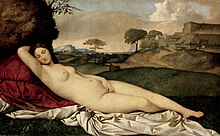
The Venetian Renaissance had a distinct character compared to the general Italian Renaissance elsewhere. The Republic of Venice was topographically distinct from the rest of the city-states of Renaissance Italy as a result of their geographic location, which isolated the city politically, economically and culturally, allowing the city the leisure to pursue the pleasures of art. The influence of Venetian art did not cease at the end of the Renaissance period. Its practices persisted through the works of art critics and artists proliferating its prominence around Europe to the 19th century.[1]

Though a long decline in the political and economic power of the Republic began before 1500, Venice at that date remained "the richest, most powerful, and most populous Italian city"[2] and controlled significant territories on the mainland, known as the terraferma, which included several small cities who contributed artists to the Venetian school, in particular Padua, Brescia and Verona. The Republic's territories also included Istria, Dalmatia and the islands now off the Croatian coast, who also contributed. Indeed, "the major Venetian painters of the sixteenth century were rarely natives of the city" itself,[3] and some mostly worked in the Republic's other territories, or further afield.[4] Much the same is true of the Venetian architects.
Though by no means an important centre of Renaissance humanism, Venice was the undoubted centre of book publishing in Italy, and very important in that respect; Venetian editions were distributed across Europe. Aldus Manutius was the most important printer/publisher, but by no means the only one.
- ^ Denys Sutton, "Venetian Painting of the Golden Age." Apollo (Archive : 1925–2005) 110, no. 213 (Nov 01, 1979): 374.
- ^ Freedberg, 123
- ^ Freedberg, 123
- ^ In the 16th century, Lorenzo Lotto, Carlo Crivelli and others; in the 18th century most major Venetian painters spent long periods abroad (see below).